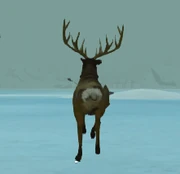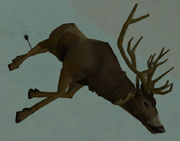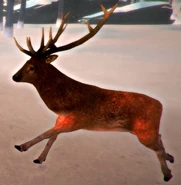Template:Wildlife InfoboxDeer are medium sized grazers in The Long Dark. Hunted by many predators, they can be a valuable resource.
Overview
Deer are timid wanderers who never attack anything and can be found in all main regions as well as in some transition zones. Commonly seen strutting through the snow, they bound away whenever they detect the slightest hint of danger. Wolves kill deer on sight, so getting deer for yourself may often require stealing them from hungry wolves. A great source of food and materials, deer typically yield more than 9kg of rich meat and deerskin boots and deerskin pants can be crafted from its hide. Oddly, the player's sprint ability is actually sufficient to almost keep pace with a running deer. This is most useful for keeping them in sight if they are shot but do not die right away.

deer running away
Behavior
Deer have two paces: walking and fleeing. Typically they stick to an invisible area, wandering about randomly within its borders. Occasionally, a wandering deer will pause and bow its head as if to graze. They will sprint away a short distance if ever they detect a nearby predator or person, but again try to remain in their designated area. If they are spooked a second time, they tend to run much farther and may also run further away from their area. Occasionally deer will double back while running and may actually run right at the player without turning away.
Prone to herding behavior, deer are usually seen in groups of up to five, and gravitate back to their fellows after being chased.
Deer at some points look around more, perhaps watching nearby animals or the player. They wiggle their ears and tails. But most noticeably, they stop and bow their heads to the ground much more often.
Food for wolves
If a wolf detects a deer, it will run down that deer and kill it. This may take a little while and cover a good distance depending on how big a head start the deer gets, but always results in the deer being killed. When a wolf gives chase in this way, other wolves are encouraged to also chase the same deer. This can result in the deer actually being killed by a wolf different from the one that started chasing it. Only the killing wolf will feed, all others will resume patrols.
Interaction
The only possible interaction with deer is to scare them. They run away from most everything. Once the player is close enough to be detected by the deer, it will run. Hearing gunshots and shooting an arrow into the snow near them is also sufficient to get them to bolt. Crouching and remaining still will lower the range at which the player is detected.
Herding
Deer may be driven along by repeatedly scaring them. They tend to run directly away, so positioning yourself opposite them from where you would like them to go is often sufficient to steer them properly.
Hunting
It is possible to kill a deer with one shot, though this is a function of scoring a "critical hit". Deer not critically shot will typically run, dropping blood, until they die. It may be noted that while the hunting rifle may cause more critical hits and is therefore more likely to drop a deer immediately without need to chase or track, the survival bow does cause significantly faster bleed outs which reduce the length of such chasing and tracking.
Critical hits
Critical hits are random occurrences, but are more likely in designated critical areas. Deer seem to have four areas: the head and neck, the front shoulder and chest, the hindquarters, and their feet. Shots to the head and neck seem to have the best chance to cause a critical hit, with shots to the front shoulder and chest being second. Shots to the feet seem to be immune to critical hits.
Bleeding wounds
All shots cause bleeding wounds. Deer will bleed out according to which area they were shot in. Bleeding wounds do not stack. That is, multiple shots to the same area will not make it bleed out any faster. Shooting a deer in an area that bleeds faster than a previous wound will cause it to bleed out as if the faster wound were caused first. A wounded deer will run until it dies.
Time to bleed out
| Zone Hit | w/ Rifle | w/ Bow |
| Head | Instant | 20 min |
| Chest | 45 min | 25 min |
| Hind | 1 hr | 40 min |
| Foot | 4 hr | 2 hr |
Strategies
- The simplest strategy for killing deer is to herd them toward wolves. Wolves always kill deer once they catch them, so no long tracking required. Once a wolf kills the deer, the decision must be made how to deal with the wolf. Scaring it away is possible, but so is waiting for it to finish eating its fill and coming back for the leftovers. The downside to the latter is that the amount of meat will decrease because the wolf ate at the carcass. Or you could now hunt the wolf while it is distracted.
- Crouching allows one to travel less detected, so crouching, combined with positioning oneself in the path of a walking deer and not moving, can develop opportunities for ambush for a single close range shot on a deer's head. Sprint to keep animal in sight if it flees until it dies.
- Longer range shooting is also quite possible once one learns how properly to aim. Deer movement is rather simple while walking and therefore predictable before they bolt.
- Flushing deer to run can also be used counter-intuitively to get them to run towards the player, allowing for close range shots. Fleeing deer occasionally double back, especially if their paths are blocked by terrain. A dynamic shot may then be taken on the deer as it charges toward or immediately after as it is moving away. Broadside attempts may be difficult to time correctly, but are also possible.
Carcass

Deer carcass
A fresh carcass contains between 8.0 and 10.0 kg of raw meat, as well as two guts and one deer hide. Carcasses will slowly freeze, increasing the time needed for the player to harvest its contents. Meat left on the carcass decays quickly, regardless of the carcass freezing. Starting a fire near a frozen carcass with thaw it.
A carcass can also be quartered into bags of meat to be taken elsewhere for harvesting. The quarters are heavier due to the inclusion of parts not otherwise used, but this does make for easier transport and less time at the site. Frozen carcasses are more difficult to quarter.
Gallery
| Fish |
| ||||||||
| Animals |
| ||||||||
| Plant | |||||||||
| Fungi | |||||||||
| Interactions | |||||||||

